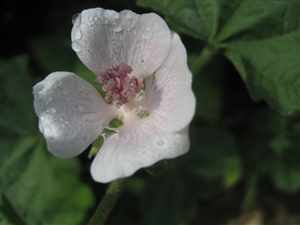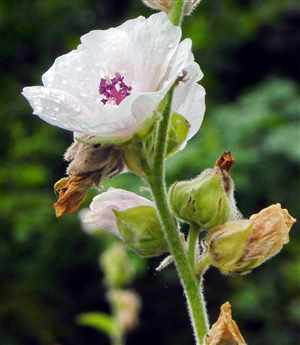Marshmallow (Althaea officinalis)
Main Facts about Marshmallow

Marshmallow is an erect perennial up to 4 feet (1.2 m) tall with soft, hairy, gray-green leaves, small, five-petaled pink or white flowers followed by round, downy fruits, and a long woody taproot, often found growing wild in marshes, bogs, and damp meadows as its name suggests. It flowers from July to September from its second year. Butterflies love it. Parts used – roots, sometimes leaves and flowers.
The herb has a healing tradition that dates back some 2,500 years. Native to marshy areas of Europe and Asia, Marshmallow belongs to the genus Althaea, a name derived from the Greek word for “heal”.
Ancient Greek physicians used Marshmallow roots to treat wounds, toothaches, and insect stings, while the Romans recommended using the roots and leaves as a laxative. 10th century Arab physicians applied Marshmallow leaf poultices as a treatment for inflammation. Medieval European healers used Marshmallow root both internally and externally to relieve toothache, sore throat, digestive upset, and urinary irritation.
The first candied Marshmallow roots were made in France centuries ago.
Using Marshmallow

The abundance of mucilage, particularly in the root, makes Marshmallow the most soothing of medicines, perfect for all kinds of irritation and inflammation, internal or external. It soothes harsh dry coughs, sore throats, asthma, and bronchitis, relieves digestive problems such as heartburn, stomach and intestinal ulcers, gastroenteritis and ulcerative colitis, and acts as a diuretic, relieving cystitis and an irritable bladder. It is often prescribed to ease the pain and discomfort of infections or inflammation of the bladder and kidneys.
Studies have shown that Marshmallow root preparations can reduce the duration and severity of coughs.
Externally, Marshmallow root compresses and poultices can soothe skin irritations. The root is also used as a topical agent in mouthwashes for inflammation of the mouth and throat.
Because of its soothing and emollient properties, Marshmallow is used in cosmetic preparations to treat irritated skin. Try using a decoction of the roots to make a hydrating facial mask.
For external use, chop the root very fine and add enough water to produce a gooey gel. Apply the gel directly to superficial wounds or sunburn.
Marshmallow is a remedy for: Cold and flu
Cooking with Marshmallow
The original Marshmallow confection was the French pâté de guimauve, made from the plant’s root. Use the tender young shoots and leaves of Marshmallow in spring salads, soups, and stews.
The roots have more substance. To prepare them, boil them gently for a few minutes, then drain and sauté them with onions.
Tea: Pour 1 cup hot water over 1 tsp dried and sliced root or 2 tsp leaves. Steep for 2 hours. Strain and drink as desired.
For sore throats, colds, and urinary tract infections: Infuse 2 to 5 g dried Marshmallow root in cold (not hot) water, and steep for 8 hours to release mucilage; drink up to 3 cups per day.
How to grow Marshmallow
Marshmallow is easy to grow from seed, cuttings, or root divisions. Plant it in full sun and moist soil with good drainage. Seeds should be planted in spring and root divisions in fall. Thin them to 2-foot spacing. In summer, mulch generously with straw, shredded leaves, or compost to retain soil moisture.
Harvest young leaves and shoots before the plant begins to bloom in midsummer. Do not harvest roots from plants less than 2 years old. In fall dig out mature roots and remove the lateral rootlets. Wash, peel, and dry them whole or sliced.
| Marine phytoplankton |
Meadowsweet
|